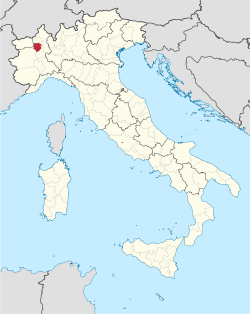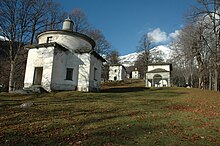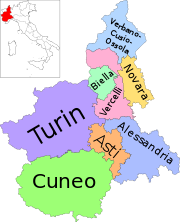Province of Biella | |
|---|---|
 Map highlighting the location of the province of Biella in Italy | |
| Country | |
| Region | Piedmont |
| Capital(s) | Biella |
| Comuni | 82 |
| Government | |
| • President | Gianluca Foglia Barbisin |
| Area | |
| • Total | 913.28 km2 (352.62 sq mi) |
| Population (1-1-2017) | |
| • Total | 178,551 |
| • Density | 200/km2 (510/sq mi) |
| GDP | |
| • Total | €4.610 billion (2015) |
| • Per capita | €25,556 (2015) |
| Time zone | UTC+1 (CET) |
| • Summer (DST) | UTC+2 (CEST) |
| Postal code | 13900 |
| Telephone prefix | 015 |
| Vehicle registration | BI |
| ISTAT | 096 |
The province of Biella (Italian: provincia di Biella; Piedmontese: provincia ëd Biela) is a province in the Piedmont region of Italy. It was created in 1992 and its capital is the city of Biella.

It has an area of 913 square kilometres (353 sq mi) and a population of 178 551 (1–1–2017). There are 82 comuni (sg.: comune) in the province [1].
The main comuni (municipalities) by population are:
| Comune | Population |
|---|---|
| Biella | 46,182 |
| Cossato | 15,058 |
| Vigliano Biellese | 8,426 |
| Candelo | 8,015 |
| Trivero | 6,617 |
| Mongrando | 4,037 |
| Valle Mosso | 3,981 |
| Occhieppo Inferiore | 3,970 |
| Ponderano | 3,904 |
| Gaglianico | 3,893 |
| Cavaglià | 3,688 |
| Andorno Micca | 3,572 |
Culture
[edit]Sacro Monte di Oropa
[edit]Biella is home to the Sacred Mountain of Oropa, which became a UNESCO World Heritage Site in 2003.[citation needed]

See also
[edit]References
[edit]- ^ Regions and Cities > Regional Statistics > Regional Economy > Regional Gross Domestic Product (Small regions TL3), OECD.Stats. Accessed on 16 November 2018.
External links
[edit]- (in Italian) Official website
- (in English) Official web site for European Sacred Mounts
45°34′39″N 8°3′4″E / 45.57750°N 8.05111°E



Well, that’s interesting to know that Psilotum nudum are known as whisk ferns. Psilotum nudum is the commoner species of the two. While the P. flaccidum is a rare species and is found in the tropical islands. Both the species are usually epiphytic in habit and grow upon tree ferns. These species may also be terrestrial and grow in humus or in the crevices of the rocks.
View the detailed Guide of Psilotum nudum: Detailed Study Of Psilotum Nudum (Whisk Fern), Classification, Anatomy, Reproduction